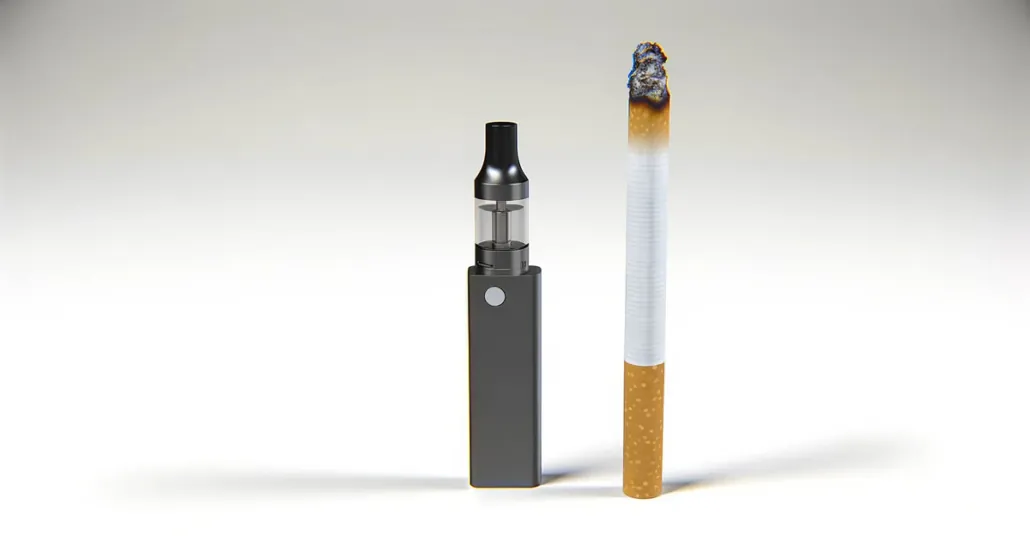The Effects of Switching from Smoking to Vaping
As more people seek alternatives to traditional cigarettes, vaping has emerged as a popular choice. Vape vendors often market their products as “healthier” tobacco alternatives or a means to quit smoking. However, it’s crucial to understand that while vaping may be less harmful than smoking, it still carries risks. In this comprehensive guide, we’ll explore the effects of switching from smoking to vaping and what you need to know to make an informed decision.
How Vaping Differs from Smoking
Vaping involves the use of e-cigarettes, which heat a liquid containing nicotine, glycerin, propylene glycol, flavorings, and other chemicals to create a vapor that the user inhales. Unlike traditional cigarettes, vapes do not have United States Food and Drug Administration (FDA) approval as smoking cessation aids.
According to the United Kingdom’s National Health Service (NHS), evidence suggests that vaping significantly reduces a person’s exposure to toxins compared to smoking tobacco, both in terms of the range of toxins and the doses delivered 1. This reduction in toxin exposure can lead to potential health benefits for those who completely switch from smoking to vaping.
The Potential Benefits of Switching to Vaping
If a person entirely replaces tobacco with vaping, it may be beneficial by reducing exposure to harmful toxins. The table below outlines the effects on the body at various intervals after quitting smoking 2:
| Time After Last Cigarette | Effects on the Body |
|---|---|
| 20 minutes | Pulse rate starts to return to normal |
| 8 hours | Oxygen levels improve; half the carbon monoxide leaves the bloodstream |
| 48 hours | Carbon monoxide completely leaves the body; lungs start clearing out mucus; taste and smell senses improve |
| 72 hours | Breathing becomes easier as bronchial tubes relax; energy levels may increase |
| 2–12 weeks | Circulation usually improves |
| 3–9 months | Lung function improves by up to 10% |
| 1 year | Heart attack risk is half that of a current smoker |
| 10 years | Risk of lung cancer mortality is half that of a current smoker |
It’s important to note that these health benefits are most likely to occur when a person completely stops smoking and switches to vaping. Dual use of both cigarettes and vapes may not lead to the same improvements in health 3.

The Risks of Vaping
While vaping may be less harmful than smoking, it is not without risks. Little research exists on the long-term effects of vaping, and the American Heart Association (AHA) does not recommend it as a proven way to quit smoking 4.
Vapes contain several potentially harmful chemicals, including aldehydes, flavorings, heavy metals (such as lead, nickel, and chromium), phenolic compounds, polycyclic aromatic hydrocarbons, tobacco alkaloids, tobacco-specific nitrosamines, and volatile organic compounds 5. These substances may damage the lungs, weaken the immune system, and affect brain development in younger users.
A study published in the American Journal of Preventive Medicine found that e-cigarette use was associated with an increased risk of respiratory disease, particularly among those who used both e-cigarettes and traditional cigarettes 6. The study highlights the need for further research into the long-term health effects of vaping.
Vaping vs. Smoking: Impact on Lung Health
A 2020 review found that vaping can cause similar effects to smoking on the lungs and heart, although these effects may occur to a lesser extent 7. While more research supports the harmful effects of smoking on lung function and the development of lung diseases like chronic obstructive pulmonary disease (COPD), only limited investigations into vaping’s effects on the lungs have taken place.
The American Lung Association highlights that young people who vape have an increased risk of coughing, wheezing, and asthma attacks 8. It also identified several compounds in e-liquid that carry a risk of lung damage or disease, including aldehydes (such as acetaldehyde and formaldehyde), acrolein (a weed killer), diacetyl (linked to severe lung diseases), and benzene (a component of car exhaust fumes).
A study published in the journal Thorax found that e-cigarette use was associated with an increased risk of respiratory symptoms, such as coughing and wheezing, even among those who had never smoked traditional cigarettes 9. The study’s authors suggest that e-cigarette use may have a negative impact on lung health, particularly among young people.

Carcinogens in Cigarettes vs. Vapes
Cigarette smoke contains over 7,000 chemicals, around 70 of which have strong links to cancer development 10. In contrast, vapes contain far fewer compounds. A 2018 public health review found that vape liquids contain around 60–70 compounds each, although some studies have identified up to 113 different chemicals across 50 brands of vape liquid 11.
While current research does not link any of these compounds to cancer, it’s important to note that it can take over 20 years for cancer to develop in a person who has smoked throughout their life 12. Vaping has only gained popularity in the past eight years, so its long-term effects are not yet clear.
A study published in the journal JAMA Network Open found that e-cigarette users had significantly higher levels of certain carcinogens, such as propylene oxide and acrylamide, compared to non-users 13. However, the levels of these carcinogens were still lower than those found in cigarette smokers.

Ecigator Sticky Open Pod Kit
The Sticky Open Pod Kit is a contemporary vaping device that combines functionality with fashion. This kit is designed with a box-style form factor, offering a compact and stylish appearance that’s ideal for vaping enthusiasts on the move.
At the heart of this kit is a Refillable Open Pod System, with a capacity of 2ml, perfect for accommodating a variety of e-liquids. The pod is equipped with a high-quality Mesh Coil that not only ensures a rich and flavorful vaping experience but also boasts durability for up to 8 Refills.
Vaping as a Smoking Cessation Tool
While some people may use vaping as a means to quit smoking, the effectiveness of this approach is still a topic of debate. A Cochrane review published in 2021 found that e-cigarettes may help some people to stop smoking, but the evidence is of low certainty 14.
The review also noted that e-cigarettes were not more effective than nicotine replacement therapy (NRT) or behavioral support for smoking cessation. The authors conclude that more research is needed to determine the long-term effects of e-cigarette use and their potential as a smoking cessation aid.
A study published in the New England Journal of Medicine found that e-cigarettes were more effective than NRT for smoking cessation, with 18% of e-cigarette users remaining abstinent from smoking at one year compared to 9.9% of NRT users 15. However, the study also found that 80% of e-cigarette users were still using the devices at one year, raising concerns about long-term nicotine dependence.
The Bottom Line
Switching from smoking to vaping may reduce exposure to harmful toxins, but it is not risk-free. The FDA has not approved vaping as an effective smoking cessation treatment, and the long-term effects of vaping, particularly in relation to cancer, are not yet known.
If you’re looking to quit smoking, consider FDA-approved methods such as nicotine replacement therapy (NRT) in the form of gum or patches, counseling, and support services. These options can help you achieve a smoke-free life without the potential risks associated with vaping.
It’s also important to remember that the most effective way to reduce the health risks associated with smoking is to quit entirely. While vaping may be less harmful than smoking, it is not a completely safe alternative.
If you do choose to vape as a means to quit smoking, it’s crucial to have a plan in place to eventually stop using e-cigarettes as well. Consult with a healthcare professional to develop a personalized smoking cessation plan that takes into account your individual needs and goals.
Reference:
- E-cigarettes and vaping ↩
- What happens after you quit smoking? ↩
- Dual use of e-cigarettes and tobacco cigarettes: product use patterns, nicotine and tobacco dependence, and quit attempts ↩
- The American Heart Association’s Stance on E-Cigarettes ↩
- Outbreak of Lung Injury Associated with the Use of E-Cigarette, or Vaping, Products ↩
- Association of E-Cigarette Use With Respiratory Disease Among Adults: A Longitudinal Analysis ↩
- E-cigarettes and cardiovascular risk: beyond science and mysticism ↩
- The Impact of E-Cigarettes on the Lung ↩
- Association of e-cigarette use with respiratory symptoms among adolescents and young adults in Canada ↩
- Harms of Cigarette Smoking and Health Benefits of Quitting ↩
- Public Health Consequences of E-Cigarettes ↩
- Cigarette Smoking and Cancer ↩
- Comparison of Nicotine and Toxicant Exposure in Users of Electronic Cigarettes and Combustible Cigarettes ↩
- Electronic cigarettes for smoking cessation ↩
- A Randomized Trial of E-Cigarettes versus Nicotine-Replacement Therapy ↩
- Minneapolis Sets $25 Minimum Price for E-Cigarettes - July 11, 2025
- Alabama Schools to Implement New Anti-Vaping Policies - July 11, 2025
- Is Vaping and Driving Illegal in Rhode Island? (2025 Guide) - July 10, 2025








